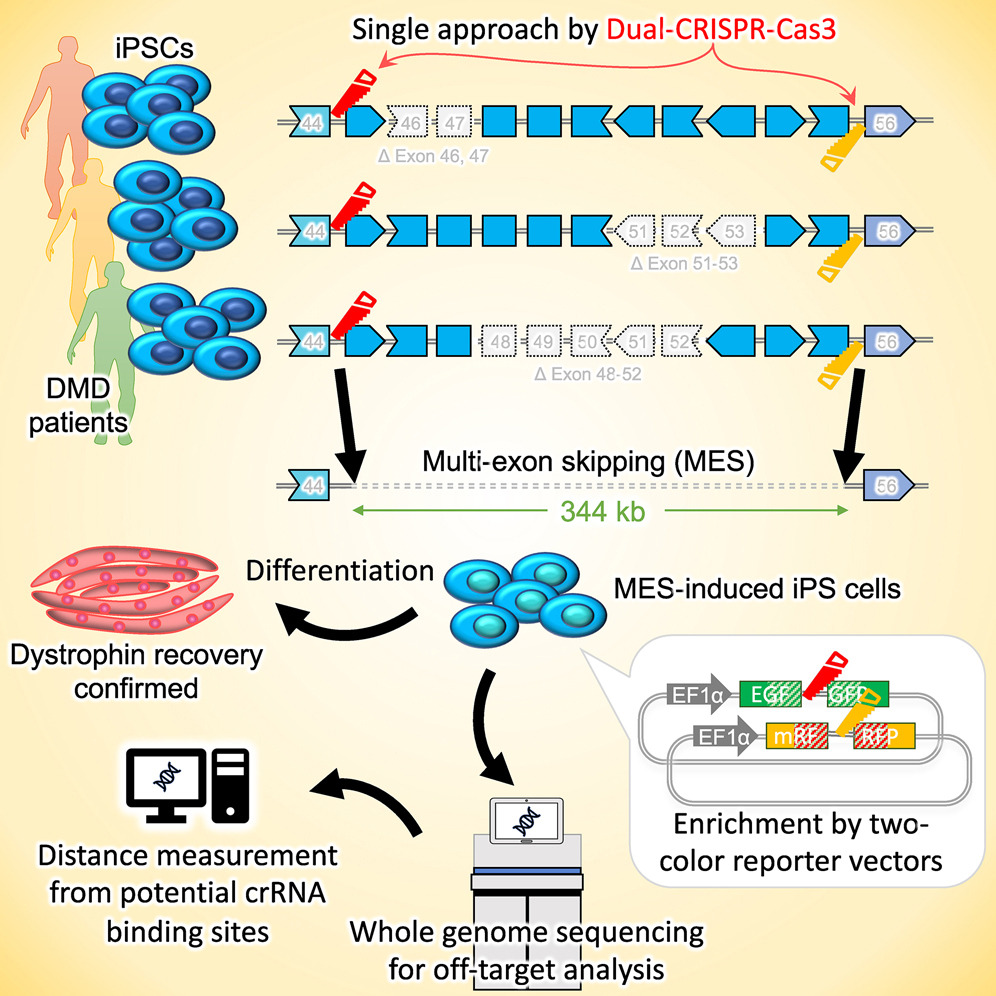Duchenne muscular dystrophy (DMD) is a severe muscle degenerative disease caused by genomic mutations that cause a frameshift in the dystrophin gene. Exon skipping is a promising approach to restore dystrophin, and the CRISPR-Cas9 system is emerging as an emerging approach. However, techniques for inducing large deletions to cover target exons spread over hundreds of bases are limited.
Recently, Akitsu Hotta's team at Kyoto University in Japan published a research paper titled: Dual CRISPR-Cas3 system for inducing multi-exon skipping in DMD patient-derived iPSCs in Stem Cell Reports, a journal of Cell Press. This study developed a dual CRISPR-Cas3 system for multi-exon skipping (MES) that can induce a deletion of up to 340 kilobases at the dystrophin exon 45-55 region in various DMD mutation patterns, producing a truncated but still functional form of dystrophin. This approach could cover more than 60% of DMD patients. In addition, the study found no significant off-target deletions.

Figure 1. Dual CRISPR-Cas3 induces a gigantic genomic deletion and restores dystrophin protein via MES induction. (Kita Y, et al., 2023)
Because there are significant differences in the patterns of mutations affecting the dystrophin gene, skipping or deleting a small segment will only work in a limited number of DMD patients. For example, the most common single-exon skipping of exons 51, 53, and 45 occurs in 13%, 8%, and 8% of DMD patients, respectively.
Multiple exon skipping (MES) is widely applicable to multiple DMD mutation patterns. By targeting mutation hotspots in the dystrophin gene, the researchers estimate that MES in exons 45-55 could benefit more than 60% of DMD patients. However, few techniques can induce a large deletion to cover target exons spread over hundreds of bases.
To overcome this obstacle, the research team used CRISPR-Cas3 to induce deletions of up to 340 kb in the dystrophin exon 45-55 region in various DMD mutation patterns. Because it is difficult to delete more than 100 bp using a single CRISPR RNA, the researchers used a pair of CRISPR RNAs inwardly sandwiching the target genomic region.
The research team pointed out the potential limitations of this dual CRISPR RNA system. First, there is variability in deletion patterns, and their precise starting and ending points cannot be fully controlled. This can be a disadvantage when large but precise removals are required. Second, the study did not demonstrate restoration of dystrophin function. Third, other methods need to be developed to improve the overall genome editing efficiency of the Cas3 system.
Akitsu Hotta, the corresponding author of the paper, said that double CRISPR-Cas3 is a promising tool to achieve gene deletion through the induction of multi-exon skipping. Once the dual CRISPR-Cas3 system can be safely and effectively delivered into skeletal muscle tissue in vivo, it is expected to be applied in future gene therapies. In addition, the technology of inducing deletions of hundreds of DNA bases itself has broad applicability in basic research. It is hoped that this research will inspire new ways to treat DMD and other genetic diseases that require the deletion of large stretches of genes.
Reference
Kita Y, et al. Dual CRISPR-Cas3 system for inducing multi-exon skipping in DMD patient-derived iPSCs. Stem Cell Reports, 2023.

